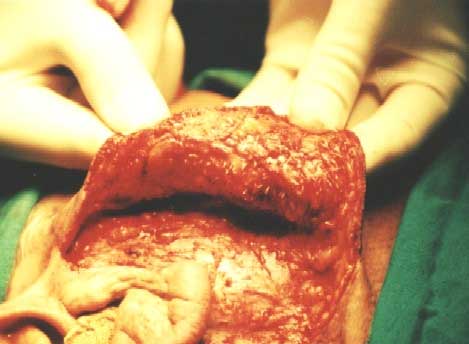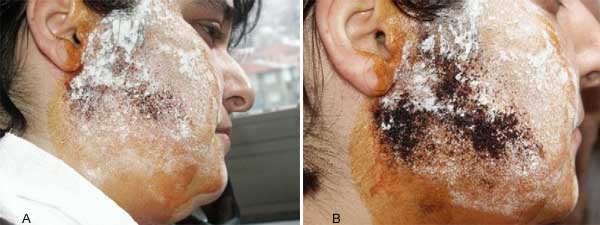DOES FLAP THICKNESS AFFECT THE INCIDENCE OF FREYS SYNDROME AFTER SUPERFICIAL PAROTIDECTOMY?
Summary
The effect of the skin flap in the development of Freys syndrome after superficial parotidectomy has been investigated by preparing the sub-superficial musculoaponeurotic system (Sub-SMAS) skin flap in 10 patients and the subcutaneous skin flap in 9 patients. Clinical questioning (subjective) and Minors starch iodine test (objective) have been used in the assessment of the patients. The time elapsed till Minors starch iodine test has been done after parotidectomy is 13 months on average in the subcutaneous group and 16 months in the sub-SMAS group. In the Sub-SMAS flap group, subjective Frey syndrome was 20% and objective Frey syndrome was found at the rate of 30%. In the subcutaneous flap group, subjective Freys syndrome was 33.3% and objective Freys syndrome was 33.3%. There is no statistically significant difference between subcutaneous and sub-SMAS flaps with respect to the frequency of Freys syndrome (p>0.05)Introduction
The incidence of symptomatic Freys syndrome after superficial parotidectomy is 10-48%[1]. In cases monitored with Minors iodine test, on the other hand, the incidence of subclinic Freys syndrome is 96-100% [2],[Another important factor affecting the development of Freys syndrome is the intraoperatively prepared skin flap. It has been reported that in cases in which the skin flap is elevated so as to contain the skin and the SMAS as a single unit, the incidence of Freys syndrome is decreased[8,10,11] In cases in which a subcutaneous flap is elevated the incidence of Freys syndrome is increased despite the higher oncological security margins[12].
In this study, the ratios of Freys syndrome in patients elevated the sub-SMAS and subcutaneous flaps have been investigated with clinical questioning (subjective) and Minors iodine starch test (objective).
Methods
Nineteen patients who came to our clinic with the diagnosis of mass in the parotid gland between 1999-2001 have been included in this prospective study. In 10 patients the Sub-SMAS skin flap and in 9 patients the subcutaneous skin flap have been elevated and superficial parotidectomy has been performed. The average age of the patients are 46 in the sub-SMAS group and 49 in the subcutaneous group. The time elapsed till Minors starch iodine test has been done after parotidectomy is 13 (range 8-17 months) months on average in the subcutaneous group and 16 (range 8 24 months) months on average in the sub-SMAS group. The minimum follow-up period is 8 months.For both groups, patients having one of the following conditions have been excluded from the study:
- 1-Patients operated on for a malign tumour in the parotid gland,
- 2-Patients re-operated on for relapse,
- 3-Patients receiving radiotherapy or patients who have had total parotidectomy or enucleation,
- 4-Diabetic patients,
- 5- Patients receiving treatment for excessive sweating or using anticholinergic drugs for other reasons,
- 6-Patients after whose operation a period of less than 8 months has elapsed.
In all the patients classical Blair incision was used .The Sub-SMAS flap was elevated over the parotid fascia with sharp dissection while preserving the continuity of the SMAS. In the part of the incision extending to the cervical region a supraplatismal flap was prepared. The subcutaneous flap was elevated from the level of the hair follicles (Figure 1).
The patients were assessed with the Minors starch iodine test with respect to Freys syndrome (objective-subclinic cases). The test was performed on both sides of the face and the side not operated on was used as the control group. First, in patients who were fasted for at least 1 hour the test region was stained with 10% iodine solution and was left to dry out. Later the region was stained completely white by sprinkling with starch powder. The patients were asked to suck or eat lemon for 1 hour to stimulate salivation. The patients were assessed with respect to the findings of Freys syndrome at 0-30-60 minutes.
During the test, the change in colour (blue-black) in the parotidectomy region was accepted as a positive result (Figure 2).
Results
There were findings of Freys syndrome in 2 patients in the Sub-SMAS group (%20, 2/10) and in 3 patients in the subcutaneous group (%33.3, 3/9) with specific clinical questioning.With Minors test, a positive test result was obtained in 3 patients (30%) in the sub-SMAS group and in 3 patients (33.3%) in the subcutaneous group. Positive results were obtained in none of the patients on the control side (the non-operated side). These values were assessed with a chi square test. There is no statistically significant difference between subcutaneous and sub-SMAS flaps with respect to the frequency of Freys syndrome (p>0.005).
The incidence of subclinic Freys syndrome was 10% (1/10) in the sub-SMAS group. Subclinic Freys syndrome was not found in the subcutaneous group.
In the clinical questioning, no reliable information could be obtained in both groups as to when the complaints had started in patients who were symptomatic so, no comparison could be made regarding this matter.
Discussion
Freys syndrome having the typical symptoms of blushing, sweating and tenderness in the parotid region while eating was first described by the French neurologist Lucia Frey in 1923[13]. The French neurologist Andre Thomas is the first physician proposing the aberrant regeneration theory towards an understanding of the physiopathology of the syndrome [8]. In various publications, it is written that the incidence of Freys syndrome is lower in extracapsular enucleation than in superficial parotidectomy and it is also written that it is less frequently observed in partial parotidectomies than in total parotidectomies[14].In the literature, it is reported that with specific questioning the rate of patients with Freys syndrome after parotidectomy is 10-30%[15]. We detected the findings of Freys syndrome at the rate of 20% in sub-SMAS group and 33.3% in subcutaneous group with specific questioning (subjective).
Another important factor affecting the development of Freys syndrome may be the intraoperatively prepared skin flap. It is reported that in cases in which the skin and the SMAS are elevated as a single unit the incidence of Freys syndrome is decreased[9,11]. Some authors report that they have reduced the incidence of Freys syndrome to the level of 2% with only a sub-SMAS flap[1]. Although the oncological security margins are higher in the case of subcutaneous (thin) flap elevation the rates of Freys syndrome are increased[12]. On the other hand, Taylor et al. report that there is no difference between subcutaneous and sub-SMAS flaps with respect to the frequency of Freys syndrome[16]. In our series, there is no statistically significant difference between subcutaneous and sub-SMAS flaps with respect to the frequency of Freys syndrome with Minors test (33.3% and 30% respectively) (p>0.05).
Although the findings of Freys syndrome frequently occur 3 months to 2 years after parotid surgery[17], cases in which symptoms emerge as early as 1 month[16] or as late as 5 years have also been reported[18]. There are difficulties in comparing the methods aimed at preventing Freys syndrome due to differences in the postoperative follow-up periods.
Conclusion
Although there are very different views in the literature, we have reached these conclusions:
2- Although the rate of symptomatic patients was % 20 (sub-SMAS) and %33.3 (subcutanous) upon specific questioning, absence of patients applying for treatment suggests that the ratio of the patient group requiring treatment for Freys syndrome is very low.
Reference
1) Allison Gr, Rappaport I. Prevention of Frey's syndrome with superficial musculoaponeurotic system interposition. Am J Surg. 1993 Oct;166(4):407-10
[ Özet ]
2) Kornblut AD, Westphal P, Miehlke A. A reevaluation of the Frey syndrome following parotid surgery. Arch Otolaryngol. 1977;103(5):258-61. [ Özet ]
3) Sultan MR, Wider TM, Hugo NE. Frey's syndrome: prevention with temporoparietal fascial flap interposition. Ann Plast Surg. 1995;34(3):292-6; discussion 296-7.
[ Özet ]
4) Sood S, Quraishi C.R, Jennings,Bradley PJ. Frey's syndrome following parotidectomy: prevention using a rotation sternocleidomastoid muscle flap. Clin Otolaryngol. 1999;24(4):365-8. [ Özet ]
5) İnal E, Kemaloğlu YK, Hiçyılmaz ÖC. Parotis Cerrahisinde Frey Sendromunun Önlenmesi ve Kozmetik Yönden Sternokleidomastoid Kas Flebi. K.B.B ve Baş Boyun Cerrahisi Dergisi. 1993;2:122-126
6) Rubinstein RY, Rosen A, Leeman D. Frey syndrome: treatment with temporoparietal fascia flap interposition. Head Neck Surg. 1999 Jul;125(7):808-11. [ Özet ]
7) Bonanno PC, Palia D, Rosenberg M, Casson P. Prophylaxis against Frey's syndrome in parotid surgery. Ann Plast Surg. 2000 May;44(5):498-501. [ Özet ]
8) Dulguerow P, Quinodoz D, Cosendai G, Piletta P,Marchal F, Lehmann W. Prevention of Frey syndrome during parotidectomy. Arch Otolaryngol Head Neck Surg. 1999 Aug;125(8):833-9. [ Özet ]
9) Singleton G, Cassini NJ. Frey's syndrome: incidence related to skin flap thickness in parotidectomy. Laryngoscope. 1980;90(10 Pt 1):1636-9. [ Özet ]
10) Casler JD, Conley J. Sternocleidomastoid muscle transfer and superficial musculoaponeurotic system plication in the prevention of Frey's syndrome. Laryngoscope. 1991;101(1 Pt 1):95-100. [ Özet ]
11) Bonanno P, Casson P. Frey's syndrome: a preventable phenomenon. Plast Reconstr Surg. 1992;89(3):452-6; discussion 457-8. [ Özet ]
12) Moulton Barrett R, Allison G, Rappaport I. Variation's in the use of SMAS (superficial musculoaponeurotic system) to prevent Frey's syndrome after parotidectomy. Int Surg. 1996;81(2):174-6. [ Özet ]
13) Laccourreye O, Bernard D, de Lacharriere O, Bazin R, Brasnu D. Frey's syndrome analysis with biosensor. A preliminary study. Arch Otolaryngol Head Neck Surg 1993;119(9):940-4. [ Özet ]
14) Wennmo C, Spandow O, Emgard P, Krouthen B. Pleomorphic adenomas of the parotid gland: superficial parotidectomy or limited excision? Laryngol Otol 1988;102(7):603-5 [ Özet ]
15) Linder TE, Huber A, Schmid S. Freys syndrome after parotidectomy: a retrospective and prospective analysis. Laryngoscope. 1997;107(11 Pt 1):1496-501. [ Özet ]
16) Taylor SM, Yoo J, Matthews WT., Lampe H.B., Trites J.R. Frey's syndrome and parotidectomy flaps: A retrospective cohort study. Otolaryngol Head Neck Surg. 2000;122(2):201-3. [ Özet ]
17) Yu Lt, Hamilton R. Frey's syndrome: prevention with conservative parotidectomy and superficial musculoaponeurotic system preservation. Ann Plast Surg. 1992;29(3):217-22. [ Özet ]
18) Laccourreye H, Laccourreye O, Cauchois R, Jouffre V, Menard M, Brasnu D. Total conservative parotidectomy for primary benign pleomorphic adenoma of the parotid gland: a 25-year experience with 229 patients. Laryngoscope 1994;104(12):1487-94. [ Özet ]






